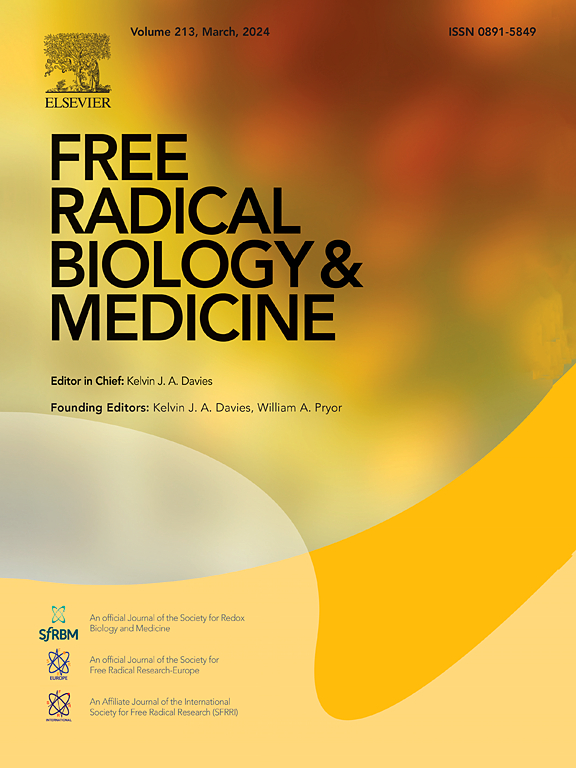Ferroptosis and PANoptosis under hypoxia pivoting on the crosstalk between DHODH and GPX4 in corneal epithelium
IF 7.1
2区 生物学
Q1 BIOCHEMISTRY & MOLECULAR BIOLOGY
引用次数: 0
Abstract
Cell death under stress conditions like hypoxia, involves multiple interconnected pathways. In this study, a stable dihydroorotate dehydrogenase (DHODH) knockdown human corneal epithelial cell line was established to explore the regulation of hypoxic cell death, which was mitigated by various cell death inhibitors, particularly by a lipid peroxyl radical scavenger liproxstatin-1 (Lip-1), suggesting that hypoxic cell death involves crosstalk of ferroptosis and PANoptosis. We discovered that both DHODH and Glutathione peroxidase 4 (GPX4) protected cells from hypoxic death by inhibiting lipid peroxidation, mitochondrial reactive oxygen species (ROS) and maintaining mitochondrial membrane potential. However, upregulation of DHODH suppressed GPX4 upstream, exhibiting a trade-off in the expression levels between DHODH and GPX4 under hypoxia, with DHODH exerting a more decisive impact on cell survival. DHODH knockdown under hypoxia did not significantly alter lipid peroxidation levels, demonstrating the balance between DHODH and GPX4 expression finely regulated cellular ferroptosis homeostasis. This study highlights the complex interplay between ferroptosis and PANoptosis in hypoxic cell death, particularly the dual role of DHODH in regulating both pathways. DHODH is not merely maintaining the quantity of mitochondria but is promoting the selection of mitochondria favorable to cell survival. These findings not only deepen our understanding of cell death but also suggest potential therapeutic strategies for diseases involving oxidative stress and mitochondrial dysfunction.

缺氧条件下角膜上皮内DHODH和GPX4串音的变化。
在缺氧等应激条件下的细胞死亡涉及多个相互关联的途径。在这项研究中,我们建立了一个稳定的二氢羟酸脱氢酶(DHODH)敲低的人角膜上皮细胞系,以探索缺氧细胞死亡的调控,各种细胞死亡抑制剂,特别是脂质过氧自由基清除剂liproxstatin-1 (lip1)减轻了缺氧细胞死亡,表明缺氧细胞死亡涉及铁下垂和PANoptosis的串串。我们发现DHODH和谷胱甘肽过氧化物酶4 (GPX4)通过抑制脂质过氧化、线粒体活性氧(ROS)和维持线粒体膜电位来保护细胞免于缺氧死亡。然而,DHODH的上调抑制了上游的GPX4,在缺氧条件下,DHODH和GPX4的表达水平呈权衡关系,DHODH对细胞存活的影响更为决定性。缺氧条件下DHODH的下调没有显著改变脂质过氧化水平,表明DHODH和GPX4表达之间的平衡精细调节了细胞铁下垂的内稳态。本研究强调了缺氧细胞死亡中铁下垂和PANoptosis之间复杂的相互作用,特别是DHODH在调节这两种途径中的双重作用。DHODH不仅维持线粒体的数量,而且促进有利于细胞生存的线粒体的选择。这些发现不仅加深了我们对细胞死亡的理解,而且为涉及氧化应激和线粒体功能障碍的疾病提供了潜在的治疗策略。
本文章由计算机程序翻译,如有差异,请以英文原文为准。
求助全文
约1分钟内获得全文
求助全文
来源期刊

Free Radical Biology and Medicine
医学-内分泌学与代谢
CiteScore
14.00
自引率
4.10%
发文量
850
审稿时长
22 days
期刊介绍:
Free Radical Biology and Medicine is a leading journal in the field of redox biology, which is the study of the role of reactive oxygen species (ROS) and other oxidizing agents in biological systems. The journal serves as a premier forum for publishing innovative and groundbreaking research that explores the redox biology of health and disease, covering a wide range of topics and disciplines. Free Radical Biology and Medicine also commissions Special Issues that highlight recent advances in both basic and clinical research, with a particular emphasis on the mechanisms underlying altered metabolism and redox signaling. These Special Issues aim to provide a focused platform for the latest research in the field, fostering collaboration and knowledge exchange among researchers and clinicians.
 求助内容:
求助内容: 应助结果提醒方式:
应助结果提醒方式:


